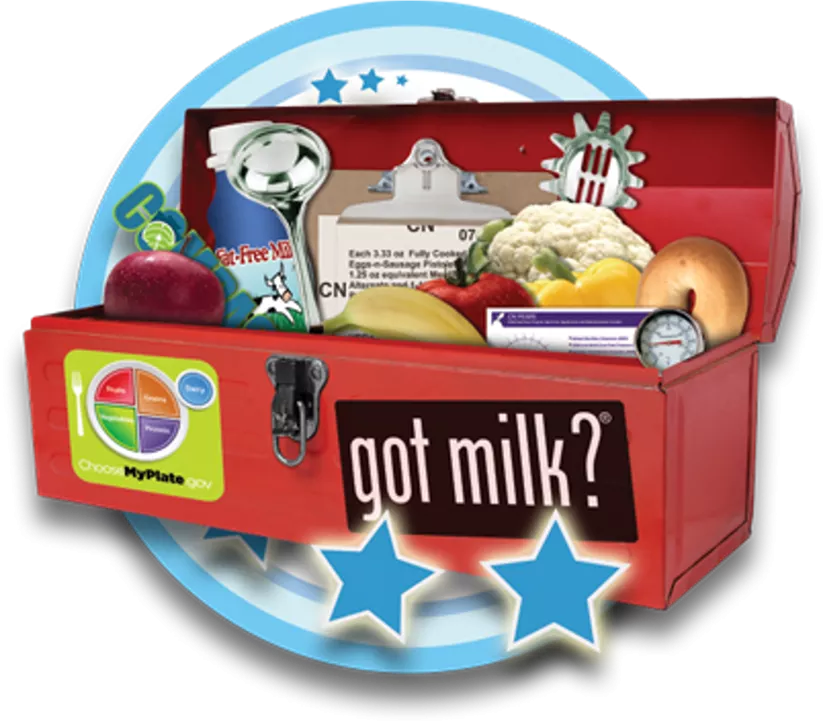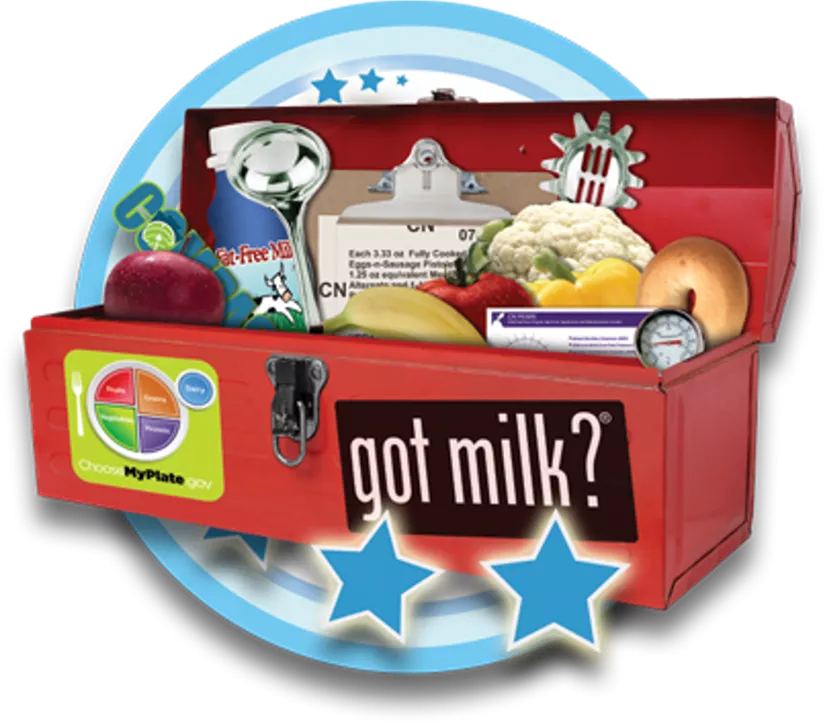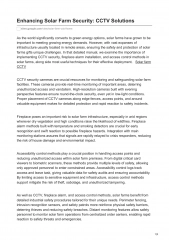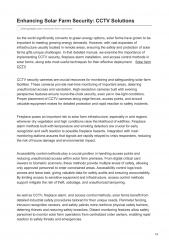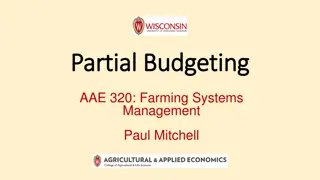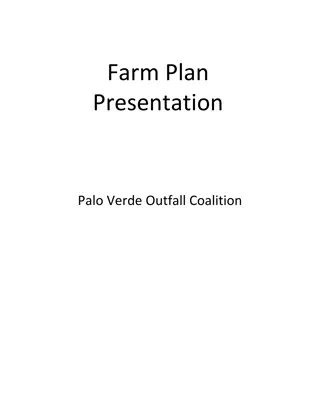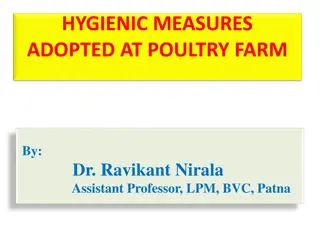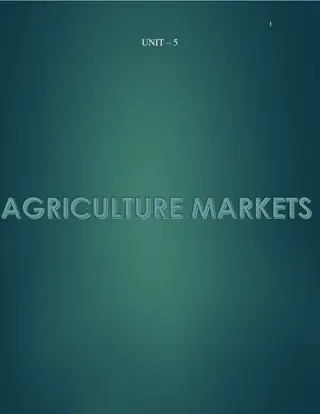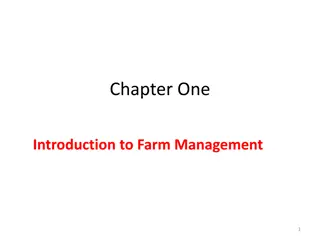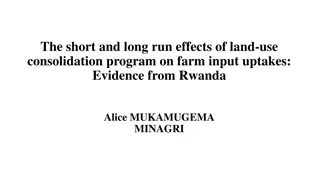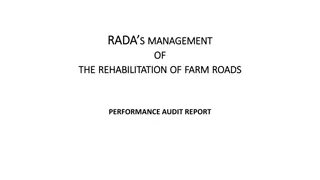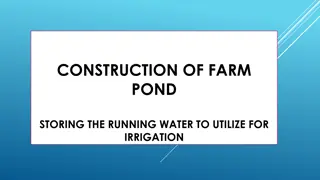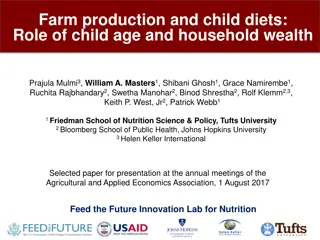Farm to School: Keeping it Safe Education
Participants in the Farm to School education section will learn about the importance of connecting schools with local farms, promoting local foods in school meals, and various activities falling under the farm to school umbrella. The module emphasizes safe practices to minimize risks when providing food to students, based on USDA and Institute of Child Nutrition recommendations. Specific guidance for Pennsylvania schools is also provided.
Download Presentation

Please find below an Image/Link to download the presentation.
The content on the website is provided AS IS for your information and personal use only. It may not be sold, licensed, or shared on other websites without obtaining consent from the author.If you encounter any issues during the download, it is possible that the publisher has removed the file from their server.
You are allowed to download the files provided on this website for personal or commercial use, subject to the condition that they are used lawfully. All files are the property of their respective owners.
The content on the website is provided AS IS for your information and personal use only. It may not be sold, licensed, or shared on other websites without obtaining consent from the author.
E N D
Presentation Transcript
Farm to School: Keeping it Safe Begin Course Begin Course Begin Course Begin Course Click Arrow to Begin Home Button Found on each page. Selecting the Home button returns you to this page. Home button returns you to this page. Home button returns you to this page. Home button returns you to this page. Home Button Found on each page. Selecting the Found on each page. Selecting the Found on each page. Selecting the Home Button Home Button Shortcut Buttons These buttons link to major sections of this course. Double-Click to navigate. H H H H Sources Section 1 | FTS Education Section 2 | School Garden Food Safety Section 3 | Local Purchasing for Use in School Meals Introduction Sources Section 1 | FTS Education Section 2 | School Garden Food Safety Section 3 | Local Purchasing for Use in School Meals Introduction
Farm to School: Keeping it Safe N NAVIGATION AVIGATION School Nutrition Toolbox School Nutrition Toolbox School Nutrition Toolbox School Nutrition Toolbox Marketing School Meals Put Course Name Here Put Course Name Here Navigation is pretty basic. Back Button, Forward Button, and Home Button. Forward Button Back Button Found on each page. Selecting the Back button returns you to the previous page. Found on each page. Selecting the Forward button advances you to the next page. Home Button Found on each page. Selecting the H H H H H H Navagation link to return to table of contents for the presentation. H H H Navagation link to return to table of contents for the presentation. Home button returns you to the very beginning page. H H H
I INTRODUCTION NTRODUCTION Schools are working to provide healthier meals to students and teach them the skills they need to make good decisions about nutrition and health. As part of these efforts, there is growing interest among schools in farm to school practices. While a primary objective of farm to school activities is to connect schools with local farms to promote purchasing of local foods for school meals, a variety of types of activities fall under the farm to school umbrella including school gardens, nutrition and agriculture classroom lessons, field trips to local farms, and taste- testing of local products. In addition to providing healthy foods in school meals programs and providing students with health and nutrition education, farm to school initiatives support local farmers and therefore strengthen local food systems. Farm to School: Keeping it Safe School Nutrition Toolbox School Nutrition Toolbox School Nutrition Toolbox School Nutrition Toolbox Marketing School Meals Put Course Name Here Put Course Name Here In any activity that involves providing food to students, it is important that safe practices be followed to minimize risk of illness and injury. Although the benefits of farm to school activities far outweigh the risks, it is important to understand the risks and take steps to avoid them. This module provides guidance on safe practices to minimize risks in farm to school programs. Most of the information in this module is based on recommendations from the USDA and the Institute of Child Nutrition (Institute of Child Nutrition). Some information is Pennsylvania specific. Pennsylvania schools with food safety questions can contact the Pennsylvania Department of Agriculture, Division of Food Safety at 717-787-4315 or 1-866-366-3723. Questions about farms and gardening can also be directed to your local Penn State Extension office. H H H H H H Navagation link to return to table of contents for the presentation. H H H Navagation link to return to table of contents for the presentation. H H H
S SECTION ECTION 1 | F 1 | FARM ARMTO TO S SCHOOL CHOOL E EDUCATION DUCATION Participants will: 1. 2. List steps to take to maintain student safety during farm field trips. Identify safety considerations for classroom food preparation and taste-testing. Farm to School: Keeping it Safe School Nutrition Toolbox School Nutrition Toolbox School Nutrition Toolbox School Nutrition Toolbox Marketing School Meals Education about agriculture, nutrition, and local foods often involves field trips to local farms to learn about food production and harvesting. It also may involve taste-testing of local products to expose students to fruits and vegetables at their peak of freshness. Sometimes, food preparation for these taste-tests occurs in classrooms. All of these activities have safety considerations. Put Course Name Here Put Course Name Here Farm Field Trips Field trips to local farms can be great opportunities for children to see where fruits and vegetables are grown and harvested. Following are some tips for maintaining safety during field trips: If possible, visit the farm in advance and become aware of any possible safety hazards. Assess whether the farm has hand-washing and restroom facilities available. Be aware of any allergies or special dietary needs that your students might have and prepare for them, especially if taste-testing will be involved. The farm may be a busy place. Farm workers may be using farm equipment and rushing to get crops harvested and stored. Maintain control of the class so they do not get in the way of the farm workers activities. Make sure good food safety practices are used for any taste testing activities. Do not allow children to taste unpasteurized milk, juice, or cider. H H H H H H Navagation link to return to table of contents for the presentation. H H H Navagation link to return to table of contents for the presentation. H H H
S SECTION ECTION 1 | F 1 | FARM P PREPARATION ARMTO REPARATIONAND TO S SCHOOL CHOOL E EDUCATION AND T TASTE DUCATION | C ASTE- -T TESTING | CLASSROOM ESTING LASSROOM F FOOD OOD Taste-testing of local fruits and vegetables gives students the opportunity to sample nutrient-rich foods at their peak of freshness. It also might be an opportunity for some students to become exposed to unfamiliar foods. There are some special safety considerations when food is prepared and taste-tests are done in classrooms. Below are some tips. Ask your school nurse and school food service director if any students have allergies or special dietary needs. Plan accordingly. Those who prepare or handle foods must first wash their hands with soap and warm water for 20 seconds. Hand sanitizer is not adequate for this purpose. Cuts must be covered with a clean bandage and a glove over the bandage. People who are sick should not prepare foods for others. If handling foods for others that will not be cooked, hands must be washed, and gloves must be worn or utensils must be used. No bare hand contact with ready-to-eat food should occur. Make sure utensils, counters, sinks, cutting boards, dishes, etc. are washed with hot soapy water and sanitized before and after use. Clean spills immediately. Some foods require prior preparation in a school kitchen. Fresh produce from packages that are labeled as pre-washed and ready-to-eat do not need to be re-washed. All other fresh produce, including those with skins and rinds that are not eaten, must be rinsed under running tap water. Firm-skin fruits and vegetables must be rubbed or scrubbed with a clean vegetable brush under running tap water. Damaged or bruised areas must be removed. Shriveled or slimy produce should be discarded. Removing outer leaves or peeling may decrease pesticides and germs. Produce and other perishable foods should be kept cold. Do not serve cut produce or other perishable foods that have been held at room temperature for more than two hours or above 90 degrees F for more than one hour. Farm to School: Keeping it Safe School Nutrition Toolbox School Nutrition Toolbox School Nutrition Toolbox School Nutrition Toolbox Marketing School Meals Put Course Name Here Put Course Name Here Continued on next slide. H H H H H H Navagation link to return to table of contents for the presentation. H H H Navagation link to return to table of contents for the presentation. H H H
S SECTION ECTION 1 | F 1 | FARM P PREPARATION ARMTO REPARATIONAND TO S SCHOOL AND T TASTE CHOOL E EDUCATION ASTE- -T TESTING DUCATION | C ESTING, P | CLASSROOM , PAGE LASSROOM F FOOD AGE 2 2 OOD Taste-testing (continued) Food that will be cooked or served hot must be brought to the proper temperature as measured with a clean calibrated food thermometer. Go to The Institute of Child Nutrition Food Safety Resources Food Safety Fact Sheets Cooking Foods [ https://theicn.org/icn-resources-a-z/food-safety ]. School food service may be able to lend and demonstrate use of a food thermometer. Foods cooked in the microwave should be covered, stirred, and rotated for even cooking. Participants should wash their hands with soap and warm water before they eat. If soap and warm water are not available, although not ideal, antibacterial hand wipes should be used. Staff should monitor to make sure that students are not touching food that others will eat. Neither staff nor student should touch any ready to eat foods with bare hands. Utensils, napkins, gloved hands, or similar should be used. Food can be individually wrapped, and/or utensils/napkins can be provided for students to take items that are not wrapped. Or staff can hand out the items using gloved hands or utensils/napkins. Any ready-to-eat food that may have been contaminated by hands or otherwise should be discarded and not served. Any food in the possession of the student may not be returned and/or re-served. It is recommended that leftover cut produce such as vegetable sticks, apple slices, melons, etc. also be discarded. Do not serve raw or undercooked meat, poultry, fish, or eggs. Do not serve unpasteurized dairy products, juices, or apple cider. Do not serve raw sprouts. Fresh squeezed juice should be consumed right after squeezing and not given to children 9 or below. Follow state and local requirements for purchasing, preparing and storing food. Farm to School: Keeping it Safe School Nutrition Toolbox School Nutrition Toolbox School Nutrition Toolbox School Nutrition Toolbox Marketing School Meals Put Course Name Here Put Course Name Here Continued on next slide. H H H H H H Navagation link to return to table of contents for the presentation. H H H Navagation link to return to table of contents for the presentation. H H H
S SECTION ECTION 1 | F 1 | FARM P PREPARATION ARMTO REPARATIONAND TO S SCHOOL AND T TASTE CHOOL E EDUCATION ASTE- -T TESTING DUCATION | C ESTING, P | CLASSROOM , PAGE LASSROOM F FOOD AGE 3 3 OOD Taste-testing (continued) Sources Farm to School: Keeping it Safe Classroom Food Preparation or Taste Testing Food Safety Tips Pennsylvania Department of Education [ http://www.schoolnutritiontoolbox.org/snt-documents/pdf/Classroom-Food-Preparation-or-Taste-testing- Food-Safety.pdf ] School Nutrition Toolbox School Nutrition Toolbox School Nutrition Toolbox School Nutrition Toolbox Marketing School Meals Put Course Name Here Put Course Name Here Handling Fresh Produce in Classrooms (USDA/ICN) [ https://theicn.org/icn-resources-a-z/produce-safety/ ] H H H H H H Navagation link to return to table of contents for the presentation. H H H Navagation link to return to table of contents for the presentation. H H H
S SECTION ECTION 2 | S 2 | SCHOOL CHOOL G GARDEN ARDEN F FOOD OOD S SAFETY AFETY Participants will: 1. Describe practices to maintain safety in a school garden in all phases, from site selection to harvesting. Identify safety considerations related to using produce from the school garden in school meals. Describe the practices to follow regarding accepting donations of produce grown in home or community gardens. Farm to School: Keeping it Safe 2. 3. School Nutrition Toolbox School Nutrition Toolbox School Nutrition Toolbox School Nutrition Toolbox Marketing School Meals Put Course Name Here Put Course Name Here Schools across the nation are using gardens to help children discover where food comes from and develop healthy eating habits. Gardens provide a learning environment, give students the opportunity to be involved in growing, harvesting, and tasting new fruits and vegetables, and involve local communities. Produce grown in school gardens may be served in classrooms or as part of school meals programs. Appropriate practices can help to minimize food safety risks. Food safety considerations exist related to the following: Site Selection, Materials, and Water Use. Chemical and Fertilizer Use. Compost and Manure Use. Growing and Harvesting Produce. Using School Garden Produce in your School Meal Program. Addressing Community Donations. Continued on next slide. H H H H H H Navagation link to return to table of contents for the presentation. H H H Navagation link to return to table of contents for the presentation. H H H
S SECTION ECTION 2 | S 2 | SCHOOL CHOOL G GARDEN ARDEN F FOOD OOD S SAFETY AFETY, P , PAGE AGE 2 2 Introduction (continued) Most of the school garden food safety practices listed in this module also apply in hydroponic gardening, which is a method of growing plants using nutrient solutions in water, without soil. Water quality is especially important, and additional food safety practices might be needed. Contact Luke LaBorde, Penn State Extension lfl5@psu.edu for guidance on additional food safety practices for your hydroponic garden. Farm to School: Keeping it Safe School Nutrition Toolbox School Nutrition Toolbox School Nutrition Toolbox School Nutrition Toolbox Marketing School Meals Put Course Name Here Put Course Name Here H H H H H H Navagation link to return to table of contents for the presentation. H H H Navagation link to return to table of contents for the presentation. H H H
S SECTION ECTION 2 | S 2 | SCHOOL CHOOL G GARDEN M MATERIALS ARDEN F FOOD ATERIALS, , AND OOD S SAFETY AND W WATER AFETY | S ATER U USE | SITE SE ITE S SELECTION ELECTION, , Locate gardens away from potential contamination sources (garbage, utilities, animals, water runoff, flooding, septic systems, etc.). Contact the utility companies or call 811, the national Call Before You Dig number [ http://www.call811.com/default.aspx ], a few days before digging to ensure that you avoid gas and electric lines. Find out the history of the soil before using it for a garden. For example, if the location is near high traffic zones, testing for lead contamination is recommended. Since testing for all possible contaminants is not cost effective, check with your local extension agent about recommended soil tests and testing facilities. Consider purchasing soil that has been commercially packaged and labeled for growing food crops. Soil purchased from a commercial source ensures traceability. Create reasonable barriers to keep wild animals away from the garden. Examples include fencing or cages over produce items such as strawberries, leafy greens, etc. Use non-toxic, non-leaching materials for raised-bed gardens, containers, stakes, or trellises. Do not use pressure-treated wood, used tires, single use plastics, old railroad ties, etc. Pressure treated lumber is of special concern because prior to 2004, this lumber contained arsenic, a known carcinogen. Today, only non-residential pressure treated lumber is produced with arsenic. However, avoiding all use of this product in school gardens is recommended. Used tires could leach petroleum, and railroad ties are coated with creosote, a possible carcinogen. Select non-allergenic and non-toxic plants. Some plants, such as rhubarb leaves, red kidney beans, and eggplant are naturally poisonous when consumed in raw form. Check with your local Penn State Extension office if you need assistance determining plant safety or toxicity. Farm to School: Keeping it Safe School Nutrition Toolbox School Nutrition Toolbox School Nutrition Toolbox School Nutrition Toolbox Marketing School Meals Put Course Name Here Put Course Name Here Continued on next slide. H H H H H H Navagation link to return to table of contents for the presentation. H H H Navagation link to return to table of contents for the presentation. H H H
S SECTION ECTION 2 | S 2 | SCHOOL M MATERIALS CHOOL G GARDEN ATERIALS, , AND ARDEN F FOOD AND W OOD S SAFETY WATER AFETY | S SE, P , PAGE | SITE AGE 2 2 ITE S SELECTION ELECTION, , ATER U USE Aside from potable municipal water sources, test all water sources such as rain barrels, cisterns, ponds, streams, wells, etc. at least annually for potentially harmful organisms, such as fecal coliforms, to make sure they meet the standards of the Environmental Protection Agency (EPA). Contact your Penn State Extension office for assistance. An additional step to help prevent contamination from water is to use drip irrigation. Water goes directly into the ground and nourishes the plant, but does not come in contact with the plant or produce. Maintain water testing records. Use food grade containers to transport water. See recommendations from Rutgers University at https://njaes.rutgers.edu/fs1218/regarding considerations using water collected in a rain barrel. School garden produce that may have been flooded by stream, river, runoff, overflow, or an unknown source may be contaminated and should not be used. Farm to School: Keeping it Safe School Nutrition Toolbox School Nutrition Toolbox School Nutrition Toolbox School Nutrition Toolbox Marketing School Meals Put Course Name Here Put Course Name Here H H H H H H Navagation link to return to table of contents for the presentation. H H H Navagation link to return to table of contents for the presentation. H H H
S SECTION ECTION 2 | S C CHEMICAL 2 | SCHOOL HEMICALAND CHOOL G GARDEN AND F FERTILIZER ARDEN F FOOD ERTILIZER U USE OOD S SAFETY SE AFETY | | Do not use any pesticides or herbicides due to potential health hazards to children. Check with your Penn State Extension office for the best non-chemical method of control for local pest problems. Read and follow the manufacturer s instructions when using fertilizer. Secure all fertilizers in a safe and locked location when not in use. Allow only adults to handle fertilizers. Check with your local health department about applicable Occupational Health and Safety Administration (OSHA) hazard communication requirements. Maintain Material Safety Data Sheets (MSDS) as required. More information is available at: http://www.osha.gov/dsg/hazcom/index.html. Maintain information on safe use and potential hazards that is available on product labels or from the manufacturer, for all fertilizers. Label the container with the common name of the fertilizer if transferring fertilizers into a dispensing container. Never use a food container. Dispose of fertilizer and its containers according to the manufacturer s instructions. Farm to School: Keeping it Safe School Nutrition Toolbox School Nutrition Toolbox School Nutrition Toolbox School Nutrition Toolbox Marketing School Meals Put Course Name Here Put Course Name Here H H H H H H Navagation link to return to table of contents for the presentation. H H H Navagation link to return to table of contents for the presentation. H H H
S SECTION ECTION 2 | S 2 | SCHOOL C COMPOST CHOOL G GARDEN OMPOSTAND ARDEN F FOOD AND M MANURE OOD S SAFETY SE AFETY | | ANURE U USE Composting is a highly complex process that requires strict attention to specific procedures and conditions. Contact your local Penn State Extension office or a composting expert for assistance. Below are some key points: Avoid the use of raw manure, as it may increase the risk of contamination from pathogens. Use of composting manure in school gardens is not recommended due to increased risk of contamination from pathogens that are not completely destroyed. Contact your Penn State Extension office to ensure that proper procedures are followed if you plan to compost manure for a school garden. Consider purchasing traceable, commercially prepared compost, if manure-based compost is desired. Consider using worms to form vermicompost. Learn about vermicomposting at: https://composting.ces.ncsu.edu/vermicomposting-2/. Add only plant products, such as fresh fruit and vegetable culls from food production (apple and pear cores and vegetable trimmings), to a school compost pile. Other plant material, such as grass clippings, leaves, and twigs also can be added to fruit and vegetable clippings. Do not use animal products, animal waste, or any cafeteria waste in a compost pile, as it might contain animal products. Harmful pathogens might be introduced through animal products and must be properly managed to ensure their destruction. Wear gloves when handling compost material. Locate the compost pile in a secure location away from potential contamination, such as garbage, water runoff, etc. Restrict access by animals as much as possible. Farm to School: Keeping it Safe School Nutrition Toolbox School Nutrition Toolbox School Nutrition Toolbox School Nutrition Toolbox Marketing School Meals Put Course Name Here Put Course Name Here H H H H H H Navagation link to return to table of contents for the presentation. H H H Navagation link to return to table of contents for the presentation. H H H
S SECTION G GROWING ECTION 2 | S ROWINGAND 2 | SCHOOL AND H HARVESTING CHOOL G GARDEN ARVESTING P PRODUCE ARDEN F FOOD OOD S SAFETY RODUCE AFETY | | A Ensure that all persons, including staff, students, and volunteers receive basic food and gardening safety training instructions according to local health regulations. Following are recommended topics: Hand washing and personal hygiene. Cleaning and sanitizing garden equipment and containers used to hold produce. Handling produce during harvest, washing, and transportation. Glove use. Check to ensure that volunteers are covered by the school district insurance policy in the event of accident or injury. Require signed permission slips for all student gardeners. Permission slips should list potential hazards of working in a school garden and identify any allergies the child may have. Do not allow anyone to work in the garden while sick, or until 24 hours after symptoms, such as vomiting or diarrhea, have subsided. Require that those working in the garden wear closed-toed shoes to prevent cuts, stings, or other injuries. Ensure that all harvesters wash hands thoroughly in warm, soapy water for at least 20 seconds, and then rinse with potable water. Ensure that all open cuts or wounds on hands, arms, or legs are properly covered prior to participating in harvest. Consider using single-use disposable gloves when harvesting, or handling, fresh produce as an extra precaution. Farm to School: Keeping it Safe School Nutrition Toolbox School Nutrition Toolbox School Nutrition Toolbox School Nutrition Toolbox Marketing School Meals Put Course Name Here Put Course Name Here H H H H H H Navagation link to return to table of contents for the presentation. H H H Navagation link to return to table of contents for the presentation. H H H
S SECTION G GROWING ECTION 2 | S ROWINGAND 2 | SCHOOL AND H HARVESTING CHOOL G GARDEN ARVESTING P PRODUCE ARDEN F FOOD RODUCE, P OOD S SAFETY , PAGE AFETY | | AGE 2 2 Harvest the garden regularly and remove any rotten produce. Use cleaned and sanitized food grade containers, such as plastic bins or buckets, to hold harvested produce. Do not use garbage bags, garbage cans, and any container that originally held chemicals. These types of containers are made from materials that are not intended for food use. Clean harvesting tools, such as knives, scissors, etc., with soap and potable water immediately before and after each gardening session. Farm to School: Keeping it Safe School Nutrition Toolbox School Nutrition Toolbox School Nutrition Toolbox School Nutrition Toolbox Marketing School Meals Put Course Name Here Put Course Name Here H H H H H H Navagation link to return to table of contents for the presentation. H H H Navagation link to return to table of contents for the presentation. H H H
S SECTION ECTION 2 | S G GARDEN 2 | SCHOOL ARDEN P PRODUCE CHOOL G GARDEN RODUCEIN ARDEN F FOOD INTHE OOD S SAFETY THE S SCHOOL AFETY | U MEAL | USING EAL P PROGRAM ROGRAM SING S SCHOOL CHOOL CHOOL M Check with your local health department to ensure that local regulations permit food from gardens to be served as part of school meals. If the harvest from the school garden will be used in the school meals program, the school garden coordinator should work cooperatively with the school nutrition director to plan and implement the garden. Discuss food safety practices in the garden with school garden coordinators. Consider asking gardeners to document their practices. Accept produce harvested from school gardens only when school nutrition staff is present to receive it. All produce dropped off or left when staff is not present should not be used in the school meal programs. Reject produce that does not meet school nutrition program standards. Receive and inspect produce harvested from school gardens according to the same procedures used to inspect produce from the district s distributors. Do not use any produce that has been noticeably contaminated by animals or insects. Refrigerate garden produce immediately, unless the particular item is normally held at room temperature. Store, prepare, and serve school garden produce separately from other sources of produce to maintain traceability. Document service of school garden produce on the menu management/ food production record. Ensure that liability for a potential foodborne illness caused by produce grown in school gardens is covered by your school district. Farm to School: Keeping it Safe School Nutrition Toolbox School Nutrition Toolbox School Nutrition Toolbox School Nutrition Toolbox Marketing School Meals Put Course Name Here Put Course Name Here H H H H H H Navagation link to return to table of contents for the presentation. H H H Navagation link to return to table of contents for the presentation. H H H
S SECTION ECTION 2 | S 2 | SCHOOL CHOOL G GARDEN C COMMUNITY ARDEN F FOOD OMMUNITY D DONATIONS OOD S SAFETY ONATIONS AFETY | A | ADDRESSING DDRESSING Members of the local community, staff, or teachers may want to donate produce grown in private or community gardens to the school meal programs. These products must be safe to serve in the school meals program. Before accepting donations, consider the following tips. Provide information to community members about USDA policies and regulations for school meal programs and state and local health requirements that you must follow. Address questions in a positive manner. Determine whether your school district has liability insurance to cover any food safety issues that may result from produce received from private or community gardens. These entities typically do not carry product liability insurance for potential food safety risks. Develop guidelines and expectations for growing and handling practices for any fruits or vegetables used in your schools. Share this information with individuals or groups who are interested in donating produce to your schools. Visit any gardens that supply produce to your school foodservice program to evaluate food safety practices. Only accept donations that are dropped off when a school nutrition staff member is present to receive them. Conduct a visual inspection of any vehicle used to transport produce to a school to assess whether it is clean. A vehicle should not be used to transport fresh produce if it is also used to transport live animals. Rotten or damaged produce should not be accepted. Farm to School: Keeping it Safe School Nutrition Toolbox School Nutrition Toolbox School Nutrition Toolbox School Nutrition Toolbox Marketing School Meals Put Course Name Here Put Course Name Here Sources For additional information, see: USDA Office of Community Food Systems Resources. Within Food Safety section, scroll to School Garden Safety subsection [ https://www.fns.usda.gov/cfs/farm-school-resources#Food%20Safety ] Food Safety Tips for School Gardens (USDA, ICN) [ https://theicn.org/icn-resources-a-z/produce-safety/ ] H H H H H H Navagation link to return to table of contents for the presentation. H H H Navagation link to return to table of contents for the presentation. H H H
S SECTION ECTION 2 | S Q Q AND 2 | SCHOOL AND A A ABOUT CHOOL G GARDEN ABOUT S SCHOOL ARDEN F FOOD CHOOL G GARDEN OOD S SAFETY ARDEN F FOOD AFETY | P OOD S SAFETY | PENNSYLVANIA AFETY ENNSYLVANIA Can fruit and vegetables from the school garden be processed (e.g. washed, blanched, and/or bagged) by students, such as in a Family and Consumer Science classroom, and delivered to the school foodservice area for school foodservice employees to cook and serve in school meals? Farm to School: Keeping it Safe School Nutrition Toolbox School Nutrition Toolbox School Nutrition Toolbox School Nutrition Toolbox Marketing School Meals Put Course Name Here Put Course Name Here No. All of the processing for school food service must occur in the approved, inspected school foodservice kitchen. However, the raw fruit and vegetables could come directly from the garden into the school kitchen to be processed. (Corn can be husked off site since that is not considered processing. Produce can also be field washed before being brought into the school foodservice facility as long as the water is potable and safe.) Can students or parent volunteers help wash, cut, blanch, and package the garden produce in the school foodservice kitchen to be used in school meals? Yes. Students or parent volunteers could help with this processing but they would be looked upon as foodservice employees and would therefore have to comply with all codes (e.g. hair restraints, hand washing, etc.). A school foodservice employee must be present to oversee the activities. H H H H H H Navagation link to return to table of contents for the presentation. H H H Navagation link to return to table of contents for the presentation. H H H
S SECTION Q Q AND ECTION 2 | S AND A 2 | SCHOOL A ABOUT CHOOL G GARDEN ABOUT S SCHOOL ARDEN F FOOD CHOOL G GARDEN OOD S SAFETY ARDEN F FOOD AFETY | P OOD S SAFETY | PENNSYLVANIA AFETY, P , PAGE ENNSYLVANIA AGE 2 2 Can school garden produce be brought into the school foodservice facility and be blanched and frozen for future use as part of school meals? Farm to School: Keeping it Safe Fresh produce can be cooked or blanched in the school foodservice facility, frozen, and then reheated for use in school meals. However, canning of low acid foods is not permitted. Canning of acidified food (i.e. pickled beets, chow chow, etc.) is only allowed if done under inspection by the Pennsylvania Department of Agriculture. If vacuum-packaging is being considered, a procedure and HACCP plan must first be approved. If you are considering canning or vacuum packaging, you must contact the Pennsylvania Department of Agriculture, Division of Food Safety prior to beginning that process School Nutrition Toolbox School Nutrition Toolbox School Nutrition Toolbox School Nutrition Toolbox Marketing School Meals Put Course Name Here Put Course Name Here What should be done with excess produce from the school garden at the end of the school year? The school should first see if the produce could be used to benefit another program such as the Summer Food Service Program. If not, they could try selling the food (as always, the profit must accrue back to the school food service account if funds from that account were used to support the garden) or donate it in accordance with state and local health/safety regulations. Note: Pennsylvania Department of Agriculture regulations allow the sale of raw fruit and vegetables commodities to the public. However, processed foods (e.g. cut, chopped, skinned, etc.) cannot be sold at public retail areas without a license. H H H H H H Navagation link to return to table of contents for the presentation. H H H Navagation link to return to table of contents for the presentation. H H H
S SECTION ECTION 3 | L S SCHOOL 3 | LOCAL CHOOL M OCAL P PURCHASING MEALS | BACKGROUND URCHASINGFOR EALS | B ACKGROUND FOR U USE SEIN IN Participants will: 1. Explain why it is critical to purchase fresh produce from farms that are using safe agricultural and handling practices. Identify ways to assess the safety of farm practices related to growing and harvesting produce. Describe the food safety considerations of purchasing fresh produce through distributors and produce cooperatives. Identify safe practices for receiving, storing, preparing, handling, and serving fresh produce. Identify safe salad bar practices. Describe the importance of traceability and steps the school nutrition department must take to ensure traceability of fresh produce. Farm to School: Keeping it Safe 2. 3. School Nutrition Toolbox School Nutrition Toolbox School Nutrition Toolbox School Nutrition Toolbox Marketing School Meals Put Course Name Here Put Course Name Here 4. 5. 6. Fresh fruits and vegetables are an important part of a healthy diet and their use in school meals is encouraged. However, much of the fresh produce that is consumed is not cooked, so if the produce is not grown or handled safely it may cause illness. The pie chart on the next slide shows the foodborne illness outbreaks associated with produce from 1998-2008. The top three sources are leafy greens, tomatoes, and melons items purchased frequently by school districts. H H H H H H Navagation link to return to table of contents for the presentation. H H H Navagation link to return to table of contents for the presentation. H H H
S SECTION S SCHOOL ECTION 3 | L CHOOL M 3 | LOCAL MEALS OCAL P PURCHASING EALS | B | BACKGROUND URCHASINGFOR ACKGROUND, P FOR U USE , PAGE SEIN IN AGE 2 2 The pie chart below shows the foodborne illness outbreaks associated with produce from 1998-2008. The top three sources are leafy greens, tomatoes, and melons items purchased frequently by school districts. Farm to School: Keeping it Safe School Nutrition Toolbox School Nutrition Toolbox School Nutrition Toolbox School Nutrition Toolbox Marketing School Meals Put Course Name Here Put Course Name Here Fresh produce can become contaminated in many ways and, when consuming fresh, uncooked produce, little can be done to make it safe once it has become contaminated. Even if produce is cooked, some contaminants may not be removed. Therefore, it is important to purchase produce from producers that are using good agricultural and good handling practices. H H H H H H Navagation link to return to table of contents for the presentation. H H H Navagation link to return to table of contents for the presentation. H H H
S SECTION S SCHOOL ECTION 3 | L CHOOL M 3 | LOCAL MEALS OCAL P PURCHASING EALS | A | ASSESSING URCHASINGFOR SSESSING F FARM FOR U USE ARM S SAFETY SEIN AFETY IN Good Agricultural Practices (GAP) is a collection of principles used to minimize food safety risks during on-farm production and post-production processes. These principles evaluate hazards and require producers to take preventative measures to reduce the opportunity for those hazards to affect the safety of the food that is produced. GAP focus on four primary components: soil, water, hands, and surfaces. Farm to School: Keeping it Safe School Nutrition Toolbox School Nutrition Toolbox School Nutrition Toolbox School Nutrition Toolbox Good Handling Practices (GHP) is a set of recommendations that address an operation s overall food safety program including issues such as worker hygiene and the cleanliness of the facility. These guidelines generally concentrate on packing and storage facilities as well as wholesale distribution centers. Marketing School Meals Put Course Name Here Put Course Name Here Some key principles for GAP and GHP include: Use of safe water on plants and produce. Proper and safe use of manure, if used. Worker health and hygiene (e.g. hand washing, not working while sick). Provision of sanitary restrooms and hand washing facilities for workers. Prevention of produce contamination in the field from unclean harvest containers, equipment, animals, soil, or unsafe water. Prevention of produce contamination during packing from storage facilities, pests, containers, pallets, equipment, dirty hands, etc. Prevention of contamination and maintenance of proper temperatures during produce transport. Vehicles should be clean and operators should be aware of what was previously transported. Traceability. Farmers should keep records to determine where, when, and who harvested and handled produce. H H H H H H Navagation link to return to table of contents for the presentation. H H H Navagation link to return to table of contents for the presentation. H H H
S SECTION S SCHOOL ECTION 3 | L CHOOL M MEALS 3 | LOCAL EALS | A | ASSESSING OCAL P PURCHASING SSESSING F FARM URCHASINGFOR ARM S SAFETY FOR U USE AFETY, P SEIN , PAGE IN AGE 2 2 USDA s Agricultural Marketing Service offers voluntary GAP and GHP audits to verify that fruits and vegetables are produced, packed, handled, and stored using safe practices. Other third parties may offer similar audits. Visit www.ams.usda.gov/gapghp for a list of farms that have been certified in Good Agricultural Practices/Good Handling Practices through USDA s audit program. Farm to School: Keeping it Safe School Nutrition Toolbox School Nutrition Toolbox School Nutrition Toolbox School Nutrition Toolbox Some buyers require farms to obtain a GAP audit before they will purchase their products. If the district buys from an organization that requires farmers to obtain a GAP audit, the district does not have to review the audit forms and document that on-farm food safety practices are being followed. If a district purchases through a distributor, the distributor may require farmers to be GAP certified in order to purchase from them. Marketing School Meals Put Course Name Here Put Course Name Here Assistance is available for Pennsylvania Farms who want to become GAP/GHP certified. Penn State Extension offers farm food safety training and/or information, some of which is available on the following websites http://extension.psu.edu/food-safety/farm and http://pubs.cas.psu.edu/PubTitle.asp?varTitle=farm+food+safety&Submit=Go. The Pennsylvania Department of Agriculture (PDA) completes GAP/GHP audits and offers partial reimbursement for farms that have successfully completed GAP/GHP certification. Contact Information: 717-787-4315 or RA- AgFruitAndVegReq@pa.gov Also, USDA funded trainings for small to mid-size growers on best practices in food safety; postharvest handling and packing produce will be available through FamilyFarmed.org [ https://onfarmfoodsafety.org/ ]. H H H H H H Navagation link to return to table of contents for the presentation. H H H Navagation link to return to table of contents for the presentation. H H H
S SECTION S SCHOOL ECTION 3 | L CHOOL M MEALS 3 | LOCAL EALS | A | ASSESSING OCAL P PURCHASING SSESSING F FARM URCHASINGFOR ARM S SAFETY FOR U USE AFETY, P SEIN , PAGE IN AGE 3 3 Schools are encouraged to purchase from GAP/GHP certified farms if possible. If the farm from which a school would like to purchase is not GAP/GHP certified, schools can refer the farm to their local Extension office and/or the PDA for information on Farm Food Safety training and certification. Also, there are several checklists which are listed below that can be used to help schools and farmers discuss farm food safety practices. For those who do not have extensive farm safety backgrounds, it is recommended that they contact Penn State Extension or the Pennsylvania Department of Agriculture for assistance. Farm to School: Keeping it Safe School Nutrition Toolbox School Nutrition Toolbox School Nutrition Toolbox School Nutrition Toolbox Marketing School Meals Put Course Name Here Put Course Name Here The Institute of Child Nutrition, Produce Safety Fact Sheets, Verifying On-farm Food Safety [ https://theicn.org/icn-resources-a-z/produce-safety ] Iowa State University Extension Checklist for Retail Purchasing of Local Fresh Produce [ https://www.safeproduce.cals.iastate.edu/files/ ] Penn State Extension Tools for Writing a Farm Food Safety Plan [ https://extension.psu.edu/tools-for-writing-a-farm-food-safety-plan ] Prior to purchasing from a local farm, it is recommended that school foodservice directors visit the farm to assess food safety practices and ask the farmer if he/she has a food safety plan. One of the above checklists could be used to assist with this assessment. Foodservice directors might want to send one of these checklists to the farmer in advance of the visit, ask him/her to complete the checklist, and review the results during the visit. H H H H H H Navagation link to return to table of contents for the presentation. H H H Navagation link to return to table of contents for the presentation. H H H
S SECTION S SCHOOL ECTION 3 | L CHOOL M MEALS 3 | LOCAL EALS | A | ASSESSING OCAL P PURCHASING SSESSING F FARM URCHASINGFOR ARM S SAFETY FOR U USE AFETY, P SEIN , PAGE IN AGE 4 4 During the visit, the foodservice director should observe as much of the farm operation as possible, including the following: Products currently growing in the field. Equipment and supplies, such as tractors, harvesting containers, harvesting equipment, cleaning and sanitizing equipment, and delivery trucks. Facilities, including packing sheds, on-site storage locations, and chemical storage facilities, if applicable. Storing, harvesting, or packing process, if possible. Farm to School: Keeping it Safe School Nutrition Toolbox School Nutrition Toolbox School Nutrition Toolbox School Nutrition Toolbox Marketing School Meals Put Course Name Here Put Course Name Here Discuss the number of days that you want from harvest to delivery to ensure that you are getting fresh produce. Depending on the product, this could be critical to the safety and quality, especially if the farmer does not have refrigerated storage or delivery. Talk to the farmer about what is realistic and reasonable. Some schools require farmers from whom they purchase products to have product liability insurance. There is a difference between food product liability and general farm liability insurance coverage. Product liability covers risks associated with the sale of products away from the farm. Food product liability insurance would cover customer claims in a lawsuit in the event of a foodborne illness outbreak. General farm insurance provides coverage only for on-farm activities and the sale of raw, unprocessed produce like Pick Your Own Produce operations. Schools should communicate with their legal departments to make decisions about the level and type of liability insurance they will require. For more information about liability insurance, see pages 16-17 of Growing the Links Between Farm and Schools: A How-To Guidebook for Pennsylvania Farmers, Schools, and Communities [http://www.rural.palegislature.us/Farm_School_Guide08.pdf ]. H H H H H H Navagation link to return to table of contents for the presentation. H H H Navagation link to return to table of contents for the presentation. H H H
S SECTION P PURCHASING ECTION 3 | L URCHASING T THROUGH 3 | LOCAL HROUGH D DISTRIBUTORS OCAL P PURCHASING ISTRIBUTORSOR URCHASINGFOR FOR U USE OR P PRODUCE SEIN RODUCE C COOPERATIVES OOPERATIVES IN S SCHOOL CHOOL M MEALS EALS | | In addition to purchasing directly from farmers, schools may purchase local products through their distributor or through farm cooperatives. Distributors may or may not be purchasing locally. Some distributors may be willing to buy local, if requested. Some distributors may require farms that sell produce to them to be GAP or GHP audited. Schools should ask their distributors about what they require. School nutrition buyers should also ask all produce suppliers about their food safety plan for handling produce in their warehouse and distributing it to customers. The suppliers should follow a plan which includes good worker hygiene, avoiding time temperature abuse, and preventing cross contamination. Farm to School: Keeping it Safe School Nutrition Toolbox School Nutrition Toolbox School Nutrition Toolbox School Nutrition Toolbox Marketing School Meals Put Course Name Here Put Course Name Here Produce cooperatives receive and distribute fresh produce from a number of different farms. Farmers pool their resources to centralize marketing, distribution, and handling of payments from customers. An advantage of buying from a cooperative instead of a single farmer is that variety and product availability may be better. Working with one cooperative versus working with several individual farms reduces paperwork and time for the school and farmer. However, because produce cooperatives get produce from multiple farms, commingling may occur. If produce is commingled, it may lose traceability, which is important in the case of a foodborne illness outbreak. The school nutrition buyer should ask the produce cooperative about their food safety plan/practices, the food safety practices of the individual farms, and about how they maintain traceability. Documentation should be requested as applicable. H H H H H H Navagation link to return to table of contents for the presentation. H H H Navagation link to return to table of contents for the presentation. H H H
S SECTION ECTION 3 | L 3 | LOCAL OCAL P PURCHASING R RECEIVING URCHASINGFOR ECEIVINGAND FOR U USE AND S STORAGE TORAGE SEIN IN S SCHOOL CHOOL M MEALS EALS | | Inspect produce at receiving based on bid specifications. Check temperatures for produce that should remain refrigerated at all times, such as lettuce, leafy greens, and all fresh-cut produce. Cut melons, cut tomatoes, other fresh cut produce, and leafy greens must be received and stored at 41 F or below. It is not as important that whole items, such as apples, oranges, or vegetables be at or below 41oF. Produce distributors store product under precise temperature and humidity conditions. They may store some whole fresh produce at 45 F and some at 55 F depending on the product. Check the Best if Used By date on fresh-cut produce at receiving. This is the manufacturer s estimate of how long the item will maintain its quality. Consider including a required shelf life for fresh products of five days or more in your specifications. The maximum shelf life listed on the packaging is an estimate based on ideal temperature, humidity, and other factors. Produce may not actually last that long depending on how it was handled during storage and transportation and how it is handled by once it arrives at the school. Do not accept produce that will be poor quality before it is able to be used. The date each produce delivery was received should be written on every item or case. This practice will help with inventory rotation and for tracking the product in the event of a food recall. Maintain produce at the recommended temperature. Cornell Cooperative Extension has published Storage Guidelines for Fruits and Vegetables [ https://rvpadmin.cce.cornell.edu/uploads/doc_500.pdf ] which includes recommendations for temperature, relative humidity, and length of storage for a variety of fruits and vegetables. Farm to School: Keeping it Safe School Nutrition Toolbox School Nutrition Toolbox School Nutrition Toolbox School Nutrition Toolbox Marketing School Meals Put Course Name Here Put Course Name Here H H H H H H Navagation link to return to table of contents for the presentation. H H H Navagation link to return to table of contents for the presentation. H H H
S SECTION ECTION 3 | L 3 | LOCAL R RECEIVING OCAL P PURCHASING ECEIVINGAND URCHASINGFOR AND S STORAGE FOR U USE TORAGE, P SEIN , PAGE IN S SCHOOL AGE 2 2 CHOOL M MEALS EALS | | Store produce at least six inches off the floor, including in walk-in refrigerators. Always store produce in a way that prevents cross contamination. For example, store fresh produce above raw meats, poultry, and eggs. Farm to School: Keeping it Safe School Nutrition Toolbox School Nutrition Toolbox School Nutrition Toolbox School Nutrition Toolbox Marketing School Meals Put Course Name Here Put Course Name Here Follow manufacturer s instructions for the product such as Keep Refrigerated or Best if Used By. Establish a policy for produce that is cut in-house to specify how long the refrigerated product may be used. Mark the product with Prepared on or Use by date. Wash produce just before preparation, not before storage. Note: If produce has excessive dirt from the garden or soil, this can be brushed and/or lightly washed off before storage. But the produce should still be washed well before use. FIFO, First In; First Out is an inventory rotation system based on using the oldest item in storage first. While this holds true in most cases, it may not hold true when purchasing fresh produce. It may be possible that produce delivered by a local farmer may last longer than produce delivered by a local distributor. The produce that is most perishable should be used first, even if it was not received first. Some produce, especially fruits, release ethylene gas to help ripen the fruit. Unfortunately, ethylene gas may damage other produce, particularly vegetables. Fruits and vegetables should be stored separately. Fruit should be stored on one side of the refrigerator and vegetables on the other side. Refer to The Institute of Child Nutrition, Produce Safety Fact Sheets, Produce Storage Chart [ https://theicn.org/icn-resources-a-z/produce-safety ]. Be sure to take and record refrigeration temperatures at least every 24 hours unless a continuous monitoring system is available. Take corrective action as needed. H H H H H H Navagation link to return to table of contents for the presentation. H H H Navagation link to return to table of contents for the presentation. H H H
S SECTION ECTION 3 | L 3 | LOCAL P PREPARATION OCAL P PURCHASING REPARATION, H URCHASINGFOR , HANDLING FOR U USE SEIN AND S SERVING ERVING IN S SCHOOL CHOOL M MEALS EALS | | ANDLING, , AND Fresh produce is often served raw. When foods are not cooked, there is no kill step to eliminate any harmful microorganisms that might be present. Therefore, proper preparation, handling, and serving are especially critical. Farm to School: Keeping it Safe The number one practice to prevent employees from spreading pathogens is proper hand washing. School Nutrition Toolbox School Nutrition Toolbox School Nutrition Toolbox School Nutrition Toolbox Marketing School Meals Put Course Name Here Put Course Name Here Proper Hand Washing Procedure 1. Wet your hands with clean, running water (warm or cold), turn off the tap, and apply soap. 2. Lather your hands by rubbing them together with the soap. Lather the backs of your hands, between your fingers, and under your nails. 3. Scrub your hands for at least 20 seconds. Need a timer? Hum the Happy Birthday song from beginning to end twice. 4. Rinse your hands well under clean, running water. 5. Dry your hands using a clean towel or air dry them. Hands should be washed when they are soiled, in between tasks, after handling chemicals, after using the restroom or sneezing/coughing, and before starting work. Even if hands were washed in the restroom, they should be washed again in the kitchen before beginning a task. H H H H H H Navagation link to return to table of contents for the presentation. H H H Navagation link to return to table of contents for the presentation. H H H
S SECTION ECTION 3 | L P PREPARATION 3 | LOCAL REPARATION, H OCAL P PURCHASING , HANDLING URCHASINGFOR ANDLING, , AND FOR U USE AND S SERVING SEIN ERVING, P IN S SCHOOL , PAGE CHOOL M AGE 2 2 MEALS EALS | | Washing Fresh Produce Do not re-wash packaged produce labeled ready to eat , washed , or triple washed. Wash all other produce under running water (even if skins or rinds won t be eaten). Use a designated vegetable brush to scrub rough surface produce like cantaloupes and potatoes. Consider posting a sign over the produce sink indicating that it is to be used only for washing fresh produce to prevent cross contamination from raw meats, poultry, or eggs. Farm to School: Keeping it Safe School Nutrition Toolbox School Nutrition Toolbox School Nutrition Toolbox School Nutrition Toolbox Marketing School Meals Put Course Name Here Put Course Name Here Never use unapproved chemicals on fresh produce. Use of chlorine is not recommended in school kitchens as a kill step for fresh produce. Note: Chemical washes or ozonated water may reduce pathogens found on the surface of fresh produce but they do not ensure that the product is safe. According to the Food and Drug Administration, they are not superior to washing produce thoroughly under cool, running, potable water. H H H H H H Navagation link to return to table of contents for the presentation. H H H Navagation link to return to table of contents for the presentation. H H H
S SECTION ECTION 3 | L P PREPARATION 3 | LOCAL REPARATION, H OCAL P PURCHASING , HANDLING URCHASINGFOR ANDLING, , AND FOR U USE AND S SERVING SEIN ERVING, P IN S SCHOOL , PAGE CHOOL M AGE 3 3 MEALS EALS | | Avoid Cross-Contamination Farm to School: Keeping it Safe Fresh produce may become cross-contaminated from many surfaces including equipment, storage containers, hands, and gloves. Surfaces must be cleaned and sanitized before and after each use. Start with clean and sanitized equipment, cutting boards, and knives. School Nutrition Toolbox School Nutrition Toolbox School Nutrition Toolbox School Nutrition Toolbox Marketing School Meals Put Course Name Here Put Course Name Here All food contact surfaces need to be cleaned and sanitized properly. The only way to know if the sanitizer is killing germs is to test it with the appropriate test strip. Chlorine, quaternary ammonia, and iodine are all effective if used at the correct concentration, temperature, and for the right amount of immersion time. Avoid cross-contaminating produce with other foods, such as meat, poultry, or eggs. Gloves can become contaminated. Gloves should be changed often and hands should be washed before putting on a new pair. Whenever gloves are contaminated or torn, hands should be washed and gloves should be changed. Pennsylvania Food Code does not allow bare hand contact with ready-to-eat food such as fresh produce. Gloves must be worn or utensils must be used to handle food that will not be cooked prior to serving. No matter where or how fresh produce is served, controlling temperatures is critical to food safety and quality. Make sure equipment is operating properly. If ice is used, the bottom of the serving pan should come into contact with the ice or ice pack. Chill foods to 41 F before placing them on the serving line. Record the internal temperature of food at least every two hours during serving. H H H H H H Navagation link to return to table of contents for the presentation. H H H Navagation link to return to table of contents for the presentation. H H H
S SECTION ECTION 3 | L S SCHOOL 3 | LOCAL CHOOL M OCAL P PURCHASING MEALS URCHASINGFOR EALS | S | SALAD FOR U USE ARS SEIN IN ALAD B BARS What follows are recommendations to reduce the risk of foodborne illness from salad bars and self-service lines. Farm to School: Keeping it Safe Preparation and Set Up Use food shields or sneeze guards. In elementary schools, equipment with a solid barrier between the students and the food is recommended. In elementary schools, pre-packaged or pre-portioned items are recommended for all self-service items. Consider offering pre-packaged or pre-portioned items for students in all grades. Place a clean and sanitized utensil in each container on the salad bar. Replace utensils at the beginning of each meal period. Label containers to identify foods and condiments. Use dispensers or single-use packages for salad dressings and other condiments. Set up the salad bar just prior to serving time. Select container size so that food is used within one meal period. Provide individually wrapped eating utensils, or keep unwrapped utensils in containers with the handles up. Serving raw or undercooked sprouts is not recommended for any children and is not allowed for children 9 years of age and younger. School Nutrition Toolbox School Nutrition Toolbox School Nutrition Toolbox School Nutrition Toolbox Marketing School Meals Put Course Name Here Put Course Name Here H H H H H H Navagation link to return to table of contents for the presentation. H H H Navagation link to return to table of contents for the presentation. H H H
S SECTION S SCHOOL ECTION 3 | L CHOOL M 3 | LOCAL MEALS OCAL P PURCHASING EALS | S | SALAD URCHASINGFOR ALAD B BARS FOR U USE ARS, P , PAGE SEIN IN AGE 2 2 Temperature Control Verify that the temperature of equipment is at 41 F or below before use. Check to be sure the bottom of the pan comes into contact with the ice or ice pack, when using them for temperature control. Chill foods to an internal temperature of 41 F or below before placing on the salad bar. Check and record internal temperatures of each food item with a clean, sanitized, and calibrated thermometer before placing it on the salad bar. Check at least every two hours to verify that it remains at or below 41 F. Farm to School: Keeping it Safe School Nutrition Toolbox School Nutrition Toolbox School Nutrition Toolbox School Nutrition Toolbox Marketing School Meals Put Course Name Here Put Course Name Here H H H H H H Navagation link to return to table of contents for the presentation. H H H Navagation link to return to table of contents for the presentation. H H H
S SECTION S SCHOOL ECTION 3 | L CHOOL M 3 | LOCAL MEALS OCAL P PURCHASING EALS | S | SALAD URCHASINGFOR ALAD B BARS FOR U USE ARS, P , PAGE SEIN IN AGE 3 3 Supervision Consider using a serving line with a solid food shield in elementary schools. Allow students to select items for assisted service rather than self-service. Employees place selected items on a plate or tray, and then pass it over the food shield to students. Monitor self-service salad bars to ensure that students do not: Touch food with bare hands. Touch food with clothing or jewelry. Cough, spit, or sneeze on food. Use utensils in multiple containers. Place foreign objects in food. Place dropped food or utensils back into containers. Use the same plate or tray on subsequent trips. Assist students with utensils, if needed. Avoid adding or layering freshly prepared food on top of food already on salad bars and self-service lines. Use a clean cloth or towel dipped in sanitizing solution to wipe surfaces during and between meal periods. Store sanitizing solution away from salad bar. Farm to School: Keeping it Safe School Nutrition Toolbox School Nutrition Toolbox School Nutrition Toolbox School Nutrition Toolbox Marketing School Meals Put Course Name Here Put Course Name Here H H H H H H Navagation link to return to table of contents for the presentation. H H H Navagation link to return to table of contents for the presentation. H H H
S SECTION S SCHOOL ECTION 3 | L CHOOL M 3 | LOCAL MEALS OCAL P PURCHASING EALS | S | SALAD URCHASINGFOR ALAD B BARS FOR U USE ARS, P , PAGE SEIN IN AGE 4 4 Farm to School: Keeping it Safe Clean Up Remove food immediately after the last meal period. Cover, label, date, and refrigerate food remaining at the end of service if it will be served the following day. Discard food that may have been contaminated, either unintentionally or intentionally. Use chemical sprays only after all food has been removed. School Nutrition Toolbox School Nutrition Toolbox School Nutrition Toolbox School Nutrition Toolbox Marketing School Meals Put Course Name Here Put Course Name Here H H H H H H Navagation link to return to table of contents for the presentation. H H H Navagation link to return to table of contents for the presentation. H H H
S SECTION ECTION 3 | L 3 | LOCAL E ENSURING OCAL P PURCHASING NSURING T TRACEABILITY URCHASINGFOR RACEABILITYOF FOR U USE OF F FRESH SEIN RESH P PRODUCE RODUCE IN S SCHOOL CHOOL M MEALS EALS | | In the event that produce purchased by a school nutrition program is recalled or in the event of a foodborne illness outbreak, the school nutrition program is responsible for tracing the produce one step back to the supplier and one step forward to when and to whom it was served. Following are tips for tracking produce: Maintain purchasing records for all produce. All purchasing records, typically invoices, should include lot numbers and other identifiers, such as pack date. If lot number and other critical information are not already included on the invoice, add it upon receipt. Maintain contact information for all suppliers, including farms, if produce is purchased directly from them. Maintain a record of all produce received from school gardens that includes product/variety name, harvest date, and persons involved in harvesting. Label all produce so that you can identify the source and trace it back through your purchasing records. Keep produce in original packaging when possible. Avoid commingling produce from different sources in storage, preparation, or service. If you commingle, you may not be able to identify the specific source of the produce in the event of a recall. If the same product is purchased from a farm, multiple farms, or a distributor, keep the products segregated through storage and service and keep records of when each product is served. Example: Apples are purchased from The Apple Farm and Distributor XYZ. Apples from The Apple Farm are stored separately and labeled clearly. The Apple Farm apples are not added to cases partially filled with apples from Distributor XYZ, or stored in empty cases that previously held apples from the distributor. Document information on the menu management/production record to enable you to trace all produce items back to your purchasing records, should a recall occur. Record information about the source of the produce--a distributor, a farm, or a school garden. Farm to School: Keeping it Safe School Nutrition Toolbox School Nutrition Toolbox School Nutrition Toolbox School Nutrition Toolbox Marketing School Meals Put Course Name Here Put Course Name Here H H H H H H Navagation link to return to table of contents for the presentation. H H H Navagation link to return to table of contents for the presentation. H H H
S SECTION E ENSURING ECTION 3 | L NSURING T TRACEABILITY 3 | LOCAL OCAL P PURCHASING RACEABILITYOF URCHASINGFOR FOR U USE OF F FRESH SEIN RODUCE, P IN S SCHOOL CHOOL M , PAGE MEALS AGE 2 2 EALS | | RESH P PRODUCE Include information on your shipping documents if produce is prepared at one location and shipped to another location for service. Label repacked fresh produce containers when distributing it to schools in quantities less than a full case. This practice will facilitate trace back to its original source in your purchasing records. Conduct a periodic mock recall of fresh produce to test your internal tracking system. Include your distributors in the mock recall to test their internal traceability program. Make sure that your distributor or supplier can trace fresh produce one step back and one step forward. Farm to School: Keeping it Safe School Nutrition Toolbox School Nutrition Toolbox School Nutrition Toolbox School Nutrition Toolbox Marketing School Meals Put Course Name Here Put Course Name Here H H H H H H Navagation link to return to table of contents for the presentation. H H H Navagation link to return to table of contents for the presentation. H H H
S SOURCES OURCES Located on the Institute of Child Nutrition (ICN) website, Produce Safety Resources page (produced by USDA/ICN). [ https://theicn.org/icn-resources-a-z/produce-safety ] Farm to School: Keeping it Safe Verifying On-Farm Food Safety [ https://theicn.org/resources/652/produce-safety-best-practices-fact-sheets/107986/verifying-on-farm-food- safety.pdf ] Good Agricultural Practices (GAPs) Presentation [ https://theicn.org/resources/636/produce-safety-university-graduate-training-resources/108043/good- agricultural-practices-gaps-presentation.pptx ] Good Agricultural Practices (GAPs) Presentation Talking Points [ https://theicn.org/resources/636/produce-safety-university-graduate-training-resources/108042/good- agricultural-practices-gaps-presentation-talking-points.pdf ] Purchasing Presentation Talking Points [ https://theicn.org/resources/636/produce-safety-university-graduate-training-resources/108048/purchasing- presentation-talking-points.pdf ] Preparation, Handling, and Service Presentation Talking Points [ https://theicn.org/resources/636/produce-safety-university-graduate-training-resources/108044/preparation- handling-and-service-presentation-talking-points.pdf ] Receiving and Storing Presentation Talking Points [ https://theicn.org/resources/636/produce-safety-university-graduate-training-resources/108050/receiving-and- storing-presentation-talking-points.pdf ] School Nutrition Toolbox School Nutrition Toolbox School Nutrition Toolbox School Nutrition Toolbox Marketing School Meals Put Course Name Here Put Course Name Here Continued on next slide. H H H H H H Navagation link to return to table of contents for the presentation. H H H Navagation link to return to table of contents for the presentation. H H H
S SOURCES OURCES Located on the Institute of Child Nutrition (ICN) website, Produce Safety Resources page (produced by USDA/ICN). [ https://theicn.org/icn-resources-a-z/produce-safety ] Farm to School: Keeping it Safe Handling Fresh Produce on Salad Bars [ https://theicn.org/resources/652/produce-safety-best-practices-fact-sheets/107982/handling-fresh-produce-on- salad-bars.pdf ] Traceability [ https://theicn.org/resources/652/produce-safety-best-practices-fact-sheets/107985/traceability.pdf ] School Nutrition Toolbox School Nutrition Toolbox School Nutrition Toolbox School Nutrition Toolbox Marketing School Meals Put Course Name Here Put Course Name Here H H H H H H Navagation link to return to table of contents for the presentation. H H H Navagation link to return to table of contents for the presentation. H H H
Farm to School: Keeping it Safe School Nutrition Toolbox H H







